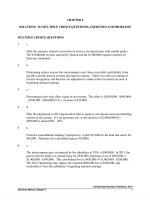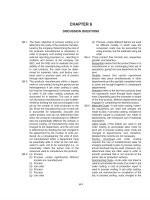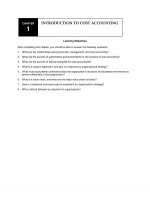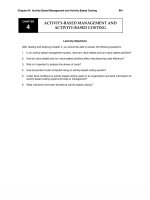Solution manual financial accounting 8th by harrison CH06
Bạn đang xem bản rút gọn của tài liệu. Xem và tải ngay bản đầy đủ của tài liệu tại đây (1.71 MB, 91 trang )
To download more slides, ebook, solutions and test bank, visit
Chapter 6
Inventory & Cost of Goods Sold
Short Exercises
(10 min.)
Inventory…………………………
Cash…………………………...
424
Billions
3.8
3.8
Accounts Receivable………….
Sales Revenue……………….
19.7
Cost of Goods Sold……………
Inventory……………………...
4.5
Cash………………………………
Accounts Receivable……….
18.8
Financial Accounting 8/e Solutions Manual
19.7
4.5
18.8
S 6-1
To download more slides, ebook, solutions and test bank, visit
(10-15 min.)
S 6-2
1. (Journal entries)
Inventory…………………………………..
Accounts Payable…………………….
120,000
Amounts Receivable……………………
Sales Revenue………………………...
150,000
Cost of Goods Sold……………………..
Inventory ($120,000 × .75)…………..
90,000
Cash ($150,000 × .30)…………………...
Accounts Receivable………………...
45,000
120,000
150,000
90,000
45,000
2. (Financial statements)
BALANCE SHEET
Current assets:
Inventory ($120,000 − $90,000)………………. $ 30,000
INCOME STATEMENT
Sales revenue………………………………………
Cost of goods sold………………………………..
Gross profit…………………………………………
Chapter 6
$150,000
90,000
$60,000
Inventory & Cost of Goods Sold
425
To download more slides, ebook, solutions and test bank, visit
(15-20 min.)
a
Average Cost
Cost of goods sold:
Average (26 ×
$154.71)
FIFO $1,260 + (17
× $160)
LIFO $4,000 + (1 ×
$140)
Ending inventory:
Average (8 ×
$154.71)
FIFO (8 × $160)
LIFO (8 × $140)
b
FIFO
S 6-3
c
LIFO
$4,022.46
$3,980
$4,140
$ 1,237.68
$1,280
$1,120
Computations:
Units sold = 26 (9 + 25 − 8)
Units in ending inventory = 8
Average cost per unit = $154.71 ($1,260 + $4,000) ÷ (9 + 25)
Cost per unit:
First purchase
= $140 ($1,260 ÷ 9 = $140)
Second purchase = $160 ($4,000 ÷ 25 = $160)
426
Financial Accounting 8/e Solutions Manual
To download more slides, ebook, solutions and test bank, visit
(10-15 min.)
S 6-4
Jefferson’s Copy Center
Income Statement
Year Ended December 31, 2010
Average
FIFO
LIFO
Sales revenue (580 × $20.25)
$11,745 $11,745
$11,745
Cost of goods sold (580 × $9.70*)
5,626
(92 × $8.90) + (488 × $9.80)
5,601
(580 × $9.80)
5,684
Gross profit
6,119
6,144
6,061
Operating expenses
3,750
3,750
3,750
Net income
$ 2,369
$2,394
$ 2,311
_____
*
Average cost per unit:
Beginning inventory (92 @ $9.00)……………..
$ 828
Purchases (680 @ $9.80)…………………………
6,664
Goods available…………………….………………
$7,492
Average cost per unit $7,492 / 772 units……
$ 9.70
Chapter 6
Inventory & Cost of Goods Sold
427
To download more slides, ebook, solutions and test bank, visit
(10-15 min.)
S 6-5
Jefferson Copy Center
Income Statement
Year Ended December 31, 2010
Average
FIFO
Sales revenue (580 × $20.25)
$11,745 $11,745
Cost of goods sold (580 × $9.70*)
5,626
(92 × $8.90) + (488 × $9.80)
5,601
(580 × $9.80)
______ ______
Gross profit
6,119
6,144
Operating expenses
3,750
3,750
Income before income tax
$2,369 $ 2,394
Income tax expense (30%)
$ 711
$ 718
*From S 6-4
428
Financial Accounting 8/e Solutions Manual
Method to
maximize
reported
income
(before
tax).
LIFO
$11,745
5,684
6,061
3,750
$ 2,311
$ 693
Method to
minimize
income tax
expense.
To download more slides, ebook, solutions and test bank, visit
(5 min.)
S 6-6
Microdata managers can purchase lots of inventory before year
end. Under LIFO, these high inventory costs go directly to cost
of goods sold in the current year. As a result, the current year’s
net income drops and that saves on income tax. Saving on
taxes is one reason companies want to decrease their income.
Student responses may vary.
(5-10 min.)
S 6-7
BALANCE SHEET
Current assets:
Inventories, at market (which is lower than cost)……. $ 42,000
INCOME STATEMENT
Cost of goods sold [$440,000 + ($57,000 − $42,000)]…… $455,000
Chapter 6
Inventory & Cost of Goods Sold
429
To download more slides, ebook, solutions and test bank, visit
(15-20 min.)
DATE:
_____________
TO:
Joe Smith, President of Saxophone Company
FROM:
Student Name
S 6-8
SUBJECT: Proposal for Increasing Net Income
We can increase net income by not buying our normal
quantities of inventory as we make sales. Inventory costs are
rising, and the company uses the LIFO inventory method.
Under LIFO, the high cost of our inventory purchases goes
straight into cost of goods sold. By slowing our purchases of
inventory, we can keep those high costs out of cost of goods
sold this year. That will keep net income from going lower and
will help net income be as high as possible. Also, our inventory
quantities are above normal, so we don’t need to buy a lot of
inventory before year end.
Student responses will vary.
430
Financial Accounting 8/e Solutions Manual
To download more slides, ebook, solutions and test bank, visit
(10-15 min.)
S 6-9
LIFO
1. Generally associated with saving income taxes.
FIFO
2. Results in a cost of ending inventory that is close
to the current cost of replacing the inventory.
Specific
unit cost
Average
3. Used to account for automobiles, jewelry, and art
objects.
4. Provides a middle-ground measure of ending
inventory and cost of goods sold.
FIFO
5. Maximizes reported income.
LIFO
6. Matches the most current cost of goods sold
against sales revenue.
LIFO
7. Results in an old measure of the cost of ending
inventory.
LCM
8. Writes inventory down when replacement cost
drops below historical cost.
LIFO
9. Enables a company to buy high-cost inventory at
year end and thereby to decrease reported
income and income tax.
FIFO
10. Enables a company to keep reported income
from dropping lower by liquidating older layers of
inventory.
Chapter 6
Inventory & Cost of Goods Sold
431
To download more slides, ebook, solutions and test bank, visit
(5-10 min.)
Gross profit percentage
=
Inventory turnover
=
Dollars in Millions
$35,482 − $15,333
$35,482
= 0.568
$15,333
= 8.6 times
($1,641 + $1,945) / 2
(5-10 min.)
+
=
−
=
432
S 6-10
S 6-11
Beginning inventory……………………………... $ 244,000
Purchases……………………………………….…
1,540,000
Goods available…………………………………...
1,784,000
Cost of goods sold:
Sales revenue………………………. $4,000,000
Less estimated gross profit (60%) (2,400,000)
Estimated cost of goods sold………………. (1,600,000)
Estimated cost of ending inventory…………... $ 184,000
Financial Accounting 8/e Solutions Manual
To download more slides, ebook, solutions and test bank, visit
(5 min.)
S 6-12
Correct
Amount
(Millions)
a.
b.
c.
d.
Net sales (unchanged)……………………………….
Inventory ($450 − $14)………………………………..
Cost of goods sold ($1,130 + $14)…………………
Gross profit ($1,900 − $1,144)………………………
$1,900
$ 436
$1,144
$ 756
(5 min.)
S 6-13
1. Last year’s reported gross profit was understated.
Correct gross profit last year was $5.5 million ($3.8 + $1.7).
2. This year’s gross profit is overstated.
Correct gross profit for this year is $3.8 million ($5.5 − $1.7).
Chapter 6
Inventory & Cost of Goods Sold
433
To download more slides, ebook, solutions and test bank, visit
(5-10 min.)
S 6-14
1. Unethical. The company falsified its ending inventory in
order to cheat the government (and the people) out of taxes.
2. Ethical. There is nothing wrong with buying inventory
whenever a company wishes.
3. Ethical. Same idea as 2.
4. Unethical. The company falsified its ending inventory and net
income.
5. Unethical. The company falsified its purchases, cost of
goods sold, and net income in order to cheat the government
(and the people) out of income tax.
434
Financial Accounting 8/e Solutions Manual
To download more slides, ebook, solutions and test bank, visit
Exercises
Group A
(15-20 min.)
E 6-15A
Req. 1
Perpetual System
1. Purchases:
Inventory…………………….……….…
Accounts Payable………………….
47,000
2. Sales:
Cash ($79,000 × .21)…….…………
Accounts Receivable ($79,000 × .79).
Sales Revenue…………….……….
16,590
62,410
Cost of Goods Sold…………………..
Inventory………………….………....
47,000
79,000
41,000
41,000
Req. 2
BALANCE SHEET
Current assets:
Inventory……………………………….
$ 14,000
INCOME STATEMENT
Sales revenue…………………………….
Cost of goods sold………………………
Gross profit……………………………….
$79,000
41,000
$38,000
Chapter 6
Inventory & Cost of Goods Sold
435
To download more slides, ebook, solutions and test bank, visit
(15-25 min.)
E 6-16A
Journal
DATE
ACCOUNT TITLES AND EXPLANATION
1 Inventory ($600 + $1,920)……………..
Accounts Payable…………………...
2,520
2 Accounts Receivable (12 @ $550)…..
Sales Revenue……………………….
6,600
Cost of Goods Sold…………………….
Inventory………………………………
1,830*
3 Sales revenue…………………………...
Cost of goods sold……………………..
Gross profit……………………………...
$6,600
1,830
$4,770
Ending inventory
($750 + $600 + $1,920 − $1,830)…...
_____
*(9 @ $150) + (3 @ $160) = $1,830
**Or, (9 @ $160) = $1,440
436
DEBIT
Financial Accounting 8/e Solutions Manual
CREDIT
2,520
6,600
1,830
$1,440**
To download more slides, ebook, solutions and test bank, visit
(10-15 min.)
E 6-17A
1.
Begin. Bal.
Purchases
Dec. 15
26
Ending bal.
Inventory
( 5 units @ $150) 750
( 4 units @ $150)
600 Cost of goods sold
(12 units @ $160) 1,920
(12 units @ $?)
( 9 units @ $?)
?
Cost of Goods Sold
Ending Inventory
(a) Specific
unit cost (6 @ $150) + (6 @ $160) = $1,860
(b) Average
cost
12 × $156*
?
(3 @ $150) + (6 @ $160) = $1,410
= $1,872
9 × $156*
= $1,404
_____
*Average cost per unit
=
($750 + $600 + $1,920)
(5 + 4 + 12)
=
$156
(c) FIFO (9 @ $150) + (3 @ $160)
=
$1,830
(9@ $160)
= $1,440
(d) LIFO (12 @ $160)
=
$1,920
(9 @ $150)
= $1,350
2. LIFO produces the highest cost of goods sold, $1,920.
FIFO produces the lowest cost of goods sold, $1,830.
The increase in inventory cost from $150 to $160 per unit
causes the difference in cost of goods sold.
Chapter 6
Inventory & Cost of Goods Sold
437
To download more slides, ebook, solutions and test bank, visit
(10 min.)
Cost of goods sold:
LIFO ($1,920) − FIFO ($1,830)……………………
× Income tax rate……………………………………
LIFO advantage in tax savings………………………
E 6-18A
$90
.35
$ 31.50
(15 min.)
E 6-19A
1.
a. FIFO
Cost of goods sold:
(12 @ $32)… ……………................
Ending inventory:
(4 @ $32) + (5@ $63)………………
b. LIFO
Cost of goods sold:
(5 @ $63) + (7@ $32)…..................
Ending inventory:
(9 @ $32)……………......................
$384
$ 443
$539
$ 288
2.
MusicPlace
Income Statement
Month Ended April 30, 2010
Sales revenue (12 @ $112) …………………………..
Cost of goods sold…………………………………….
Gross profit……………………………………………..
Operating expenses…………………………………...
Income before income tax……………………………
Income tax expense (35%)……………………………
Net income………………………………………………
438
Financial Accounting 8/e Solutions Manual
$1,344
384
960
260
700
245
$ 455
To download more slides, ebook, solutions and test bank, visit
(15 min.) E 6-20A
Millions
1. Gross profit:
Sales revenue……………………………
Cost of goods sold
FIFO: 800,000 × $5…………………..
LIFO: (500,000 × $3) + (200,000 × $4) +
(100,000 ×5)………………………….
Gross profit………………………………
2.
FIFO
$4.8
LIFO
$4.8
4.0
$0.8
2.8
$2.0
Gross profit under FIFO and LIFO differ because inventory
costs decreased during the period.
3. Valuing the ending inventory at $5.00 per unit will, result in
an ending inventory valued at $4,000,000 (800,000 @ $5)
while the FIFO inventory was valued at $2,800,000 (500,000 @
$3) + (200,000 @ $4) + (100,000 @ $5). This would amount to
changing the method of accounting for inventories from FIFO
to LIFO. The difference of $1,200,000 between the ending
inventories would reduce cost of goods sold by $1,200,000
and increase net income by the same amount.
While
accounting changes like this are permissible under GAAP,
they must be for a business purpose, and not merely to
increase the manager’s bonus. The company’s auditors will
likely view the change unfavorably.
In addition, such a
change will likely increase the company’s tax bill, so it is
unlikely that the owners of the company will go along with it
either.
Chapter 6
Inventory & Cost of Goods Sold
439
To download more slides, ebook, solutions and test bank, visit
(5-10 min.)
E 6-21A
Thames Garden Supply
Income Statement (partial)
Year Ended July 31, 2010
Sales revenue ………………………………………………
Cost of goods sold [$67,000 + ($15,000 − $10,800)]…
Gross profit…………………………………………………
$116,000
71,200
$ 44,800
Note: Cost is used for beginning inventory because cost is
lower than market. Market (replacement cost) is used for
ending inventory because market is lower than cost at
year end.
440
Financial Accounting 8/e Solutions Manual
To download more slides, ebook, solutions and test bank, visit
(15-20 min.)
a.
b.
c.
d.
c.
e.
f.
g.
h.
E 6-22A
(Amounts in millions or billions)
$ 66
$19 + $65 − $18 = $66
$ 39
$105 − $66 = $39
Must first solve for d
$ 93
$138 − $45= $93
$ 94
$27 + c − $93 = $28; c = $94
$ 92
$60 + $32 = $92
$ 25
f + $56 − $21 = $60; f = $25
$ 5
$11 + $30 − g = $36; g = $5
$ 48
$84 − $36 = $48
Crane Company
Income Statement
Year Ended December 31, 2010
(Millions)
Net sales
$ 105
Cost of goods sold
Beginning inventory
$ 19
Net purchases
65
Goods available
84
Ending inventory
(18)
Cost of goods sold
66
Gross profit
39
Operating and other expenses
41
Net income (Net loss)
$(2)
Chapter 6
Inventory & Cost of Goods Sold
441
To download more slides, ebook, solutions and test bank, visit
(20-30 min.)
Company
Gross Profit
Percentage
E 6-23A
Inventory Turnover
Crane
$39
$105
= 0.371
$66
= 3.6 times
($19 + $18) / 2
Foster
$45
$138
= 0.326
$93
= 3.4 times
($27 + $28) / 2
Allen
$32
$92
= 0.348
$60
= 2.6 times
($25 + $21) / 2
Matthews
$48
$84
= 0.571
$36
= 4.5 times
($11 + $5) / 2
Matthews has the highest gross profit percentage, 57.1%.
Matthews has the highest rate of inventory turnover, 4.5 times.
Based on these data, Matthews looks the most profitable
because Matthews gross profit percentage is approximately
1½ times the other companies’ gross profit percentage. And
Matthew’s inventory turnover is about 25% higher than Crane’s
turnover.
442
Financial Accounting 8/e Solutions Manual
To download more slides, ebook, solutions and test bank, visit
(15 min.)
E 6-24A
Req. 1 and 2
Gross profit percentage =
1
FIFO
$144,000 − $85,200
$144,000
= 0.408
Inventory turnover
=
2
LIFO
$144,000 − $92,800
$144,000
= 0.356
$85,200
($21,000 + $23,000) / 2
$92,800
($8,000 + $17,000) / 2
= 3.9 times
= 7.4 times
Req. 3
FIFO makes the company look better on the gross profit
percentage.
Req. 4
LIFO makes the company look better on the rate of inventory
turnover.
Chapter 6
Inventory & Cost of Goods Sold
443
To download more slides, ebook, solutions and test bank, visit
(10-15 min.)
E 6-25A
Year ended January 31, 2010
Millions
Budgeted cost of goods sold ($6,500 × 1.10)………..
$7,150
Budgeted ending inventory……………………………..
2,400
Budgeted goods available………….……………………
9,550
Actual beginning inventory……………………………..
(2,100)
Budgeted purchases……………………………………..
$7,450
(10-15 min.)
Beginning inventory………………………
Net purchases………………………………
Goods available……….…………………...
Estimated cost of goods sold:
Net sales revenue………………………
Less estimated gross profit of 35%…
Estimated cost of goods sold………...
Estimated cost of inventory destroyed..
E 6-26A
$ 47,500
30,900
78,400
$ 62,100
(21,735)
40,365
$ 38,035
Another reason managers use the gross profit method to
estimate ending inventory is to test the reasonableness of
ending inventory.
444
Financial Accounting 8/e Solutions Manual
To download more slides, ebook, solutions and test bank, visit
10-15 min.)
E 6-27A
Big Blue Sea Marine Supply
Income Statement (Corrected)
Years Ended September 30, 2010 and 2009
2010
2009
Sales revenue
$143,000
$120,000
Cost of goods sold:
Beginning inventory $21,000
$ 9,000
Net purchases
74,000
67,000
Goods available
95,000
76,000
Ending inventory
(19,000)
(21,000)*
Cost of goods sold
76,000
55,000
Gross profit
67,000
65,000
Operating expenses
28,000
24,000
Net income
$ 39,000
$ 41,000
*$14,500 + $6,500 = $21,000
Big Blue Sea actually performed poorly in 2010, compared to
2009, with net income down from $41,000 to $39,000.
Chapter 6
Inventory & Cost of Goods Sold
445
To download more slides, ebook, solutions and test bank, visit
Exercises
Group B
(15-20 min.)
E 6-28B
Req. 1
Perpetual System
1. Purchases:
Inventory…………………….……….…
Accounts Payable………………….
2. Sales:
Cash ($74,000 × .24)…….…………
Accounts Receivable ($74,000 × .76).
Sales Revenue…………….……….
Cost of Goods Sold…………………..
Inventory………………….………....
49,000
4,900
17,760
56,240
74,000
40,000
40,000
Req. 2
446
BALANCE SHEET
Current assets:
Inventory……………………………….
$ 17,000
INCOME STATEMENT
Sales revenue…………………………….
Cost of goods sold………………………
Gross profit……………………………….
$ 74,000
40,000
$ 34,000
Financial Accounting 8/e Solutions Manual
To download more slides, ebook, solutions and test bank, visit
(15-25 min.)
E 6-29B
Journal
DATE
ACCOUNT TITLES AND EXPLANATION
DEBIT
1 Inventory ($960 + $1,870)……………..
Accounts Payable…………………...
2,830
2 Accounts Receivable (14 @ $625)…..
Sales Revenue……………………….
8,750
Cost of Goods Sold…………………….
Inventory………………………………
2,250*
3 Sales revenue…………………………...
Cost of goods sold……………………..
Gross profit……………………………...
$8,750
2,250
$6,500
Ending inventory
($1,120 + $960 + $1870 − $2,250)….
CREDIT
2,830
8,750
2,250
$1,700**
_____
*(13 @ $160) + (1 @ $170) = $2,250
**Or, (10 @ $170) = $1,700
Chapter 6
Inventory & Cost of Goods Sold
447
To download more slides, ebook, solutions and test bank, visit
(10-15 min.)
E 6-30B
1.
Begin. Bal.
Purchases
May 15
26
Ending bal.
Inventory
( 7 units @ $160 1,120
( 6 units @ $160)
960
(11 units @ $170) 1,870
( 10 units @ $?)
?
Cost of Goods Sold
(a) Specific
unit cost
(b) Average
cost
?
Ending Inventory
(8 @ $160) + (6 @ $170) = $2,300
14 × $165*
Cost of goods sold
(14 units @ $?)
(5 @ $160) + (5 @ $170) = $1,650
= $2,310
10 × $165*
= $1,650
_____
*Average cost per unit
=
($1,120 + $960 + $1,870)
(7 + 6 + 11)
=
$165
(c) FIFO (13 @ $160) + (1 @ $170) =
$2,250
(10 @ $170)
= $1,700
(d) LIFO (11 @ $170) + (3 @ $160) =
$2,350
(10 @ $160)
= $1,600
2. LIFO produces the highest cost of goods sold, $2,350.
FIFO produces the lowest cost of goods sold, $2,250.
The increase in inventory cost from $160 to $170 per unit
causes the difference in cost of goods sold.
448
Financial Accounting 8/e Solutions Manual









